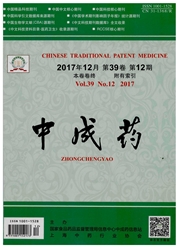

 中文摘要:
中文摘要:
目的探讨通脉止血方(三七、生地黄、茜草等)对免疫性血小板减少性紫癜(ITP)患儿T淋巴细胞亚群的影响。方法 2013年9月到2015年12月选择在河北省中医院儿科诊治的免疫性血小板减少性紫癜患儿80例,随机均分为对照组(泼尼松)和治疗组(泼尼松联合通脉止血方),观察期均为3个月。结果治疗后,治疗组与对照组的有效率分别为90.0%和65.0%(P〈0.05),血小板计数分别为(116.33±22.49)×109/L和(76.02±21.94)×109/L,明显高于治疗前的(30.13±13.34)×109/L和(30.87±12.84)×109/L(P〈0.05),治疗组治疗后的血小板计数明显高于对照组(P〈0.05)。两组治疗后的分化簇CD3+与分化簇CD4+值都明显上升,而分化簇CD8+值均明显降低(P〈0.05)。治疗后治疗组与对照组相比,CD3+、CD4+明显升高,CD8+明显下降(P〈0.05)。结论通脉止血方可促进T淋巴细胞亚群恢复正常,改善体液免疫与细胞免疫功能,从而达到免疫性血小板减少性紫癜的总体改善。
 英文摘要:
英文摘要:
AIM To investigate the effects of Tongmai Zhixue Recipe( Notoginseng Radix et Rhizoma,Rehmanniae Radix,Rubiae Radix et Rhizoma,etc.) on T lymphocyte subsets in children with immune thrombocytopenic purpura( ITP). METHODS From September 2013 to December 2015 in department of pediatrics of Hebei Provincial Hospital of TCM,eighty children with ITP were selected and randomly equally divided into control group( prednisone) and treatment group( prednisone combined with Tongmai Zhixue Recipe). Their periods of observation were both three months. RESULTS After the treatment,the effective rates in the treatment group and control group were 90% and 65%( P 〈 0. 05),respectively. Their platelet counts were( 116. 33 ± 22. 49) × 109/ L and( 76. 02 ± 21. 94) × 109/ L,which were significantly higher than those before the treatment [( 30. 13 ±13. 34) × 109/ L and( 30. 87 ± 2. 84) × 109/ L]( P 〈 0. 05),and the platelet counts of the treatment group were higher than those of the control group after the treatment( P 〈 0. 05). After the treatment,CD3~+and CD4~+values in the two groups were increased significantly,and CD8~+values were decreased markedly with significant difference( P 〈 0. 05). In addition,compared with the control group,CD3~+and CD4~+values in the treatment group after the treatment were increased significantly,and CD8~+value was decreased markedly( P 〈 0. 05). CONCLUSION Tongmai Zhixue Recipe can promote T lymphocyte subsets return to normal,improve the functions of humoral immunity and cellular immunity,so as to achieve the overall improvement of immune thrombocytopenic purpura.
 同期刊论文项目
同期刊论文项目
 同项目期刊论文
同项目期刊论文
 期刊信息
期刊信息
